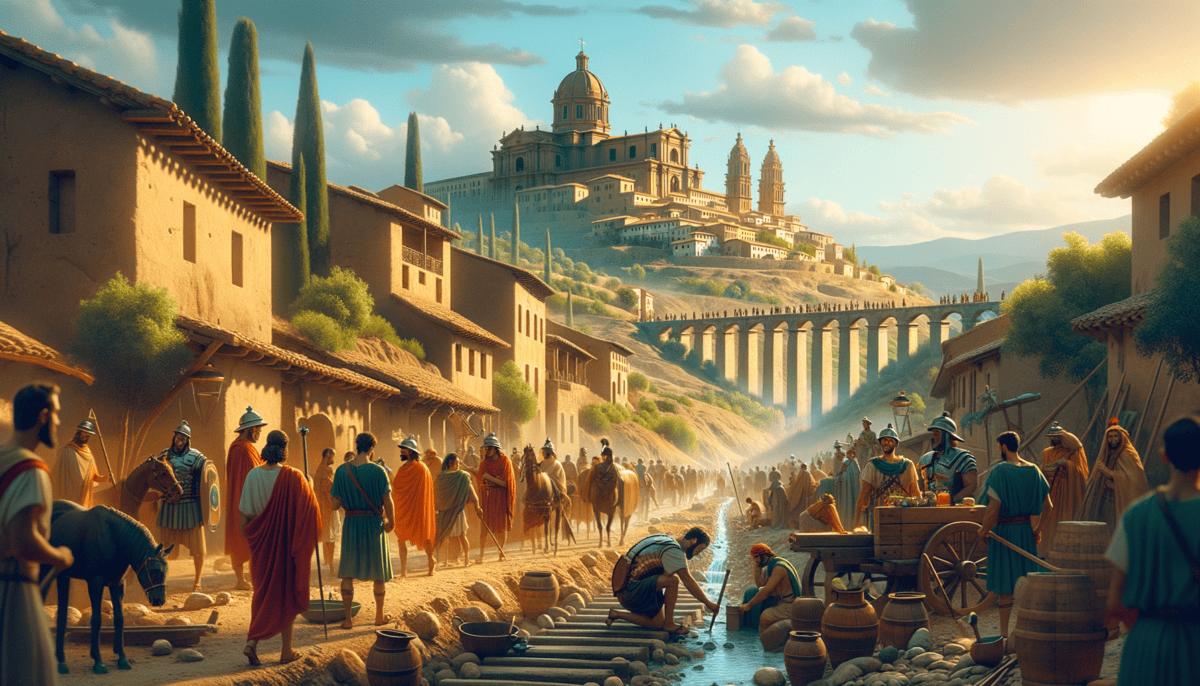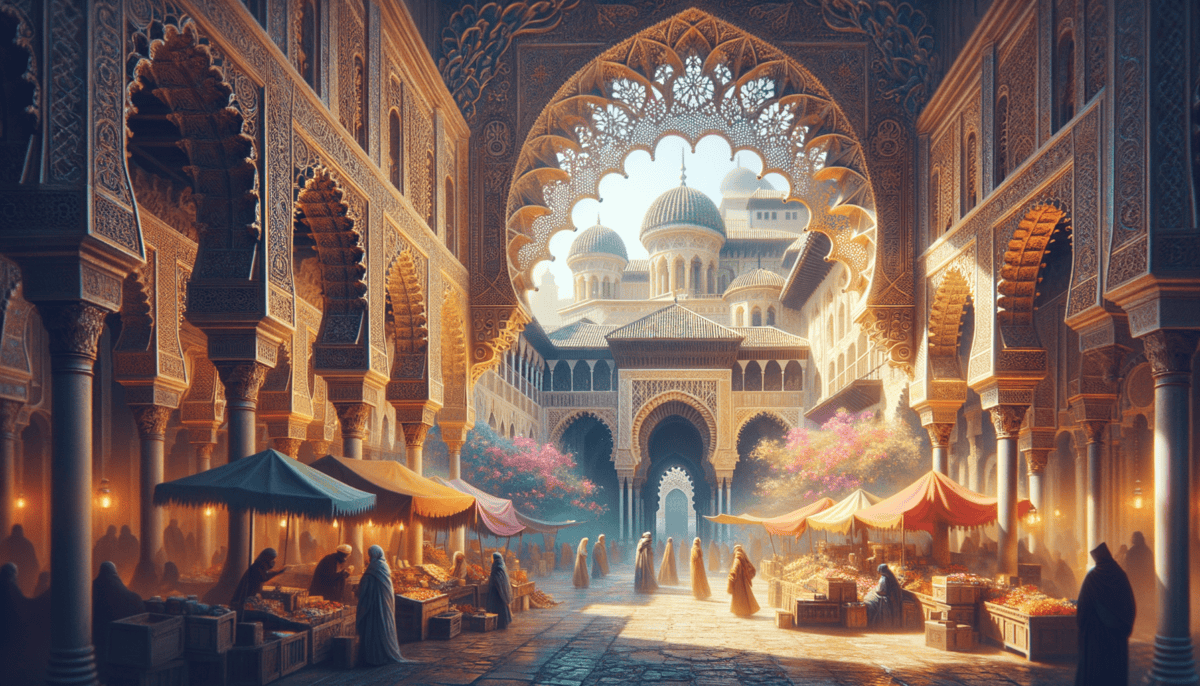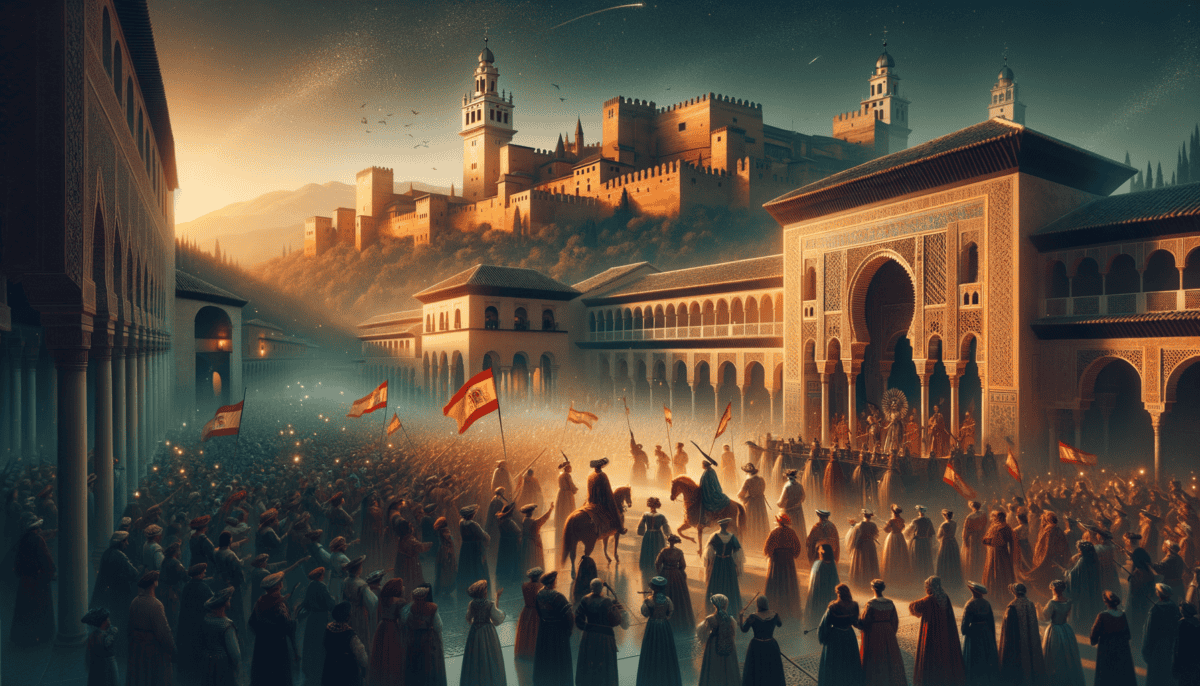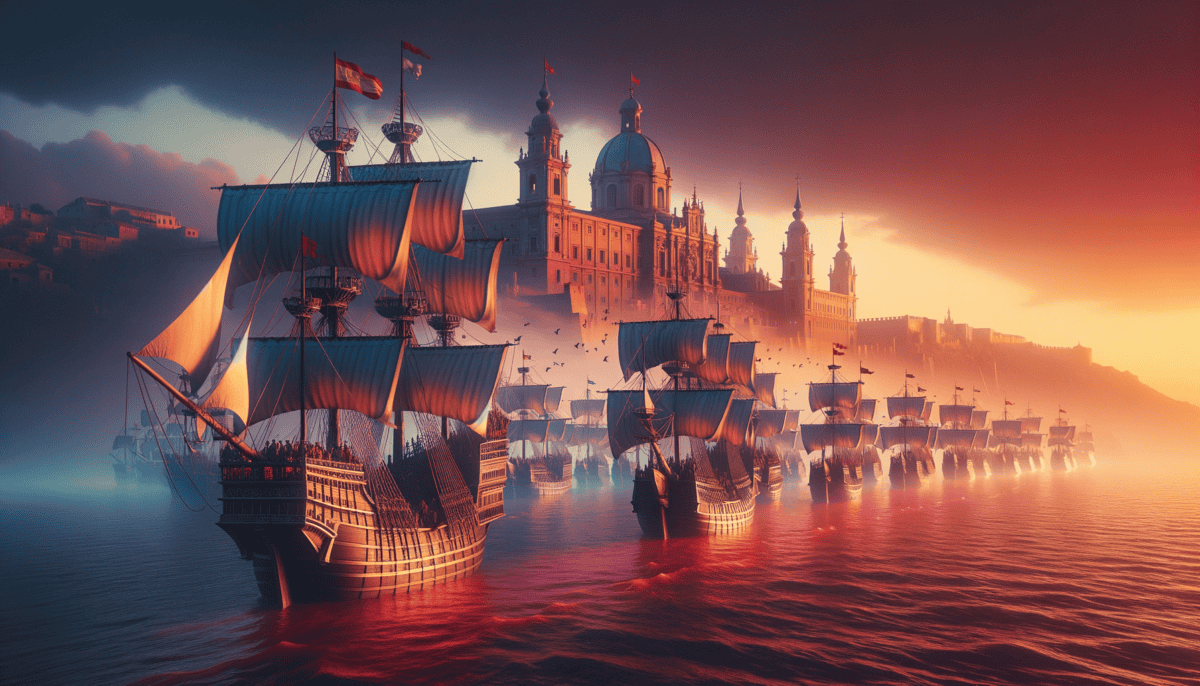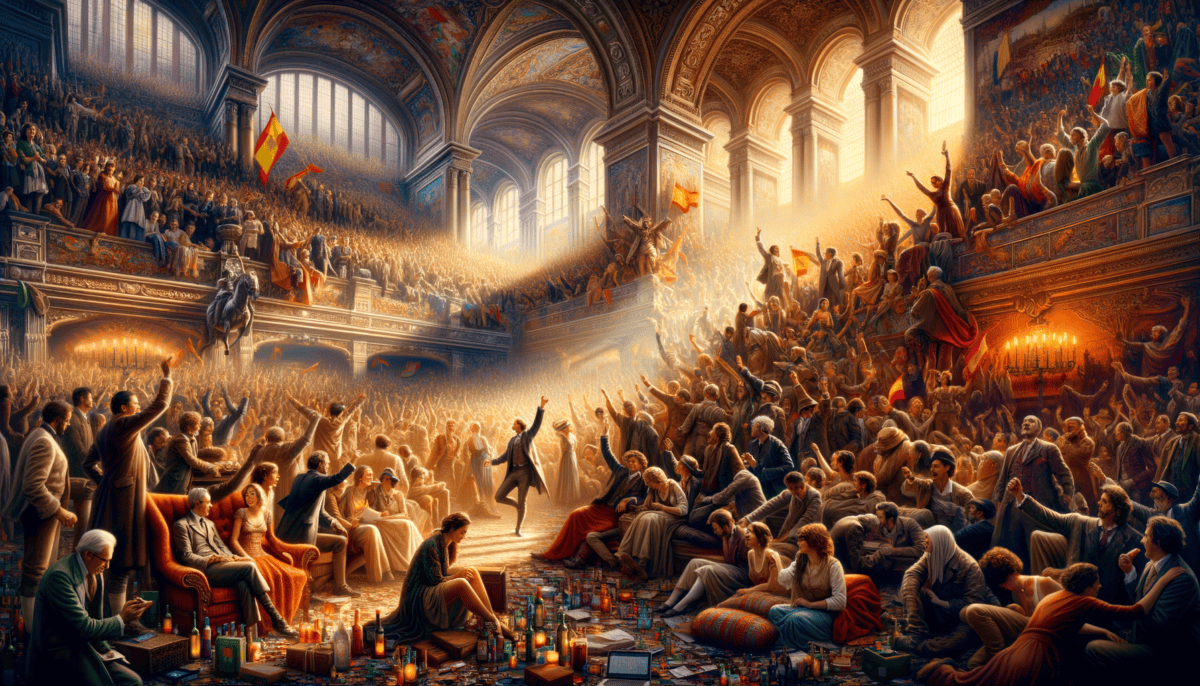Ancient Roots
Long, long ago, in a beautiful land called Spain, there lived brave people who made their homes between two big seas. The sun shone bright and warm on the mountains, valleys, and beaches that made up this special place.
"Look at those mountains!" little Marco said to his father as they walked through their village. "They touch the sky!"
The Pyrenees Mountains stood tall and proud, like giant guardians watching over the land. These mountains helped keep Spain safe and special through many years of history.
The first people who lived in Spain were very clever. They found ways to live off the land by:
- Growing food in the rich soil
- Fishing in the blue waters
- Making homes in caves and on hillsides
- Trading with visitors from far away
- Learning to work with metal tools
One day, new people called the Celtiberians came to Spain. They brought exciting new things with them! They taught everyone how to make better tools and build stronger houses.
"These strangers have such interesting ways," said Ana, a young girl watching the newcomers. "Look at their colorful clothes and the way they dance!"
The Celtiberians weren't the only visitors. Ships started arriving from far across the sea. The people on these ships came from places called Phoenicia and Greece. They built trading posts along the coast and shared their stories, food, and ways of life.
The First Big Changes
Spain became like a giant meeting place where different people shared their ideas. Some brought new ways to grow food, while others taught about writing and counting. Everyone learned from each other!
Little Maria watched as her grandmother made pottery the way her family had done for hundreds of years. "Why do you make the swirls that way?" she asked.
Her grandmother smiled. "These patterns tell our story, little one. They show how our people have lived here since the beginning."
As time went on, more and more people came to live in Spain. They built bigger towns and learned to work together. They made beautiful art on cave walls and created songs that told stories of their lives.
"Tell me again about the old times," young Pedro would ask his grandfather in the evening.
His grandfather would point to the stars and say, "Our ancestors looked at these same stars and dreamed of making this land great. And look how their dreams came true!"
The weather in Spain helped make it special too. The warm sun made plants grow well, and the rain filled the rivers. People could grow lots of different foods – juicy oranges, sweet grapes, and golden wheat.
The sea brought new friends and new ideas to Spain's shores. Each wave carried possibilities, and each visitor left a mark on the growing story of this amazing land.
As night fell over the ancient hills, the stars would twinkle above just as they had for thousands of years. The old stories say that if you listen carefully on quiet evenings, you can still hear the whispers of those first brave people who made Spain their home.
The mix of different people and ideas made Spain stronger and more interesting. Everyone brought something special to share – new foods to try, new songs to sing, and new ways to live. Together, they were building something amazing that would last for many years to come.
Empires of Conquest
The Romans sailed across the big blue sea to Spain. Their ships were huge, filled with soldiers in shiny armor. ️
“Look at their red capes!” whispered little Julia to her brother. “They march like rows of ants!”
• Strong stone roads
• Big cities with tall buildings
• Clean water in pipes
• New words and ways to write
• Better ways to grow food
Marcus, a young Roman boy, made friends with Julio, a Spanish boy. They played together in the new city streets.
“Why do your people build such straight roads?” Julio asked one day.
Marcus smiled proudly. “So we can travel faster and connect all parts of Spain together!”
The Romans were very good builders. They made special places called aqueducts that carried water through the air like magic bridges. Some of these still stand today!
“Our cities are like small pieces of Rome,” the Roman governor would say. “We bring the best of our world to Spain.”
Life changed a lot under Roman rule. Spanish children went to Roman schools. They learned to speak Latin and wear Roman clothes. Spanish families ate new foods like olive oil and special fish sauce.
New Ways of Living
The Romans built beautiful houses with colorful floor pictures made of tiny stones. They created places where people could watch plays and sports. Everyone gathered in big markets to buy and sell things.
“Mama, why are there pictures on the floor?” asked little Clara, looking at the pretty mosaics.
“The Romans love beauty,” her mother explained. “They make art everywhere they can.”
Spanish people learned many useful things from the Romans. They discovered better ways to grow grapes for wine and olives for oil. They learned to make stronger tools and better ships.
Some days, Julio would sit with his grandfather, watching the busy streets of their new Roman city. “The world is changing,” his grandfather would say. “But change can be good. Look at all we’ve learned!”
Spanish mines gave the Romans silver and gold. Spanish farms gave them wheat and oil. In return, the Romans gave Spain new ideas and ways to live better.
As the years passed, Spain became more and more like Rome. But it kept its own special ways too. It was like mixing two different colors of paint to make a new, more beautiful color.
At night, in homes across Spain, families would gather to tell stories. Some were old Spanish tales, and some were new Roman ones. Together, they made a richer, fuller story of Spain.
The Romans made Spain stronger and bigger than ever before. They connected it to a huge empire that stretched across many lands. Spanish people could now travel to far places and learn new things.
Years later, little Julia grew up and had children of her own. She would tell them stories about the day the Romans came, and how they helped make Spain into something new and wonderful.
And so, Spain grew and changed, keeping the best of its old ways while learning exciting new ones. The story of Spain was growing bigger and more interesting with each passing day.
The Moorish Millennium
The warm sun rose over Spain as new visitors arrived from across the sea. They were the Moors, bringing with them magical gardens, amazing buildings, and wise teachers.
Young Hassan watched from the hilltop as the newcomers built their first mosque. “Father, why are their buildings so different?” he asked.
“They bring their own special way of making things beautiful,” his father replied. “Look at those curved arches – they’re like rainbows made of stone!”
• New ways to water gardens
• Beautiful buildings with fancy designs
• Smart ways to study stars and numbers
• Tasty new foods and spices
• Stories full of wisdom
In the city of Córdoba, a young girl named Isabella made friends with Fatima, whose family had come with the Moors. They loved exploring the new gardens together.
“How do you make the water dance like that?” Isabella asked, watching the fountains sparkle.
Fatima smiled. “It’s called science! My people know how to make water flow uphill using clever tricks.”
“Three different peoples lived together in Spain now – Christians, Muslims, and Jews. They shared their stories and learned from each other.”
A Time of Learning
In the great libraries of Al-Andalus (what they called Spain), children learned about numbers, stars, and medicine. The Moors brought books filled with knowledge from far-away lands.
Little Ahmad loved visiting the palace gardens. “The flowers smell like heaven,” he would say, breathing in the sweet scents of jasmine and orange blossoms.
His teacher explained how the Moors created special ways to water plants. “We make the desert bloom,” she said proudly.
In the bustling markets, people traded goods from all over the world. Spanish children tasted new fruits like oranges and learned about spices that made food taste amazing.
“Try this sugar candy,” Fatima offered to Isabella one day. “My uncle brings it from far away.”
The most beautiful sight was the Alhambra palace. Its walls were covered in designs that looked like lace made of stone. Water flowed everywhere, making music as it fell.
At night, scholars would gather to study the stars. They wrote down their discoveries in books that helped sailors find their way across the seas.
“The stars are like a map in the sky,” explained the wise astronomer to young Hassan. “They help us know where we are going.”
But not everything was peaceful. Sometimes the Christian kingdoms in the north fought with the Moorish lands in the south. Yet even then, they couldn’t help but admire each other’s achievements.
Years passed, and the children grew up learning both old and new ways. They spoke different languages and celebrated different festivals. The music of Spain became richer, mixing Spanish guitars with Moorish drums.
Isabella’s grandson became a doctor, using knowledge from both Moorish and Spanish traditions to help people. “This is the gift of our mixed heritage,” he would say. “We learn from everyone.”
The Moorish time in Spain lasted many hundreds of years. During this time, Spain became a place where science, art, and wisdom flourished like the gardens they built.
Every evening, as the sun set behind the beautiful Moorish towers, people would gather to tell stories. Some were old Spanish tales, some were Moorish wisdom, and some were new stories they created together.
Reconquista and Unification
The sun rose over Spain as Queen Isabella and King Ferdinand stood on their castle balcony. They had a big dream – to make all of Spain one kingdom.
“Look at our beautiful land,” Isabella said to Ferdinand. “One day, it will all be united.”
• Two kingdoms joined together
• New rules about religion
• Better ways to fight battles
• More trade between cities
• Stronger castle walls
Little Maria watched from her window as soldiers marched through the streets. Their armor sparkled in the morning light. ⚔️
“Why are there so many soldiers, Mama?” she asked.
“The king and queen want to make Spain one big family,” her mother explained. “But some people don’t want to join.”
“Changes came to Spain like waves on the shore – some big, some small, but all changing the shape of the land.”
In the city of Granada, the last Moorish king looked sad. His beautiful palace would soon belong to Ferdinand and Isabella. Many of his people would have to leave their homes.
Young Alfonso made friends with a Moorish boy named Karim before Karim’s family had to move away. “Will you write to me?” Alfonso asked.
“I’ll try,” Karim promised. “I’ll never forget our games in the orange groves.”
In the castle kitchens, Cook Maria taught her helpers how to make new dishes. “We must remember all the good things we learned from our friends,” she said, adding spices to her stew.
The queen’s advisors were busy planning something exciting. They met with a sailor named Christopher Columbus who had big ideas about sailing west across the ocean.
“There might be new lands out there,” Columbus told the queen. “Spain could find them first!”
Isabella listened carefully. “This could be the start of something wonderful,” she thought.
Meanwhile, in the countryside, farmers worked together to grow more food. Spanish horses became famous all over Europe for their strength and beauty.
Young Diego loved watching the horses run. “Someday, I’ll ride across Spain and see everything,” he told his sister.
In the cities, craftsmen built grand churches with tall spires that reached toward the sky. Artists painted beautiful pictures showing Spain’s history.
The royal couple sent teachers to start new schools. They wanted everyone to learn to read and write in Spanish. Children learned songs about brave knights and kind queens.
“Remember,” teachers would say, “we are all part of one big Spanish family now.”
Isabella and Ferdinand worked to make trade better between cities. They made sure roads were safe for travelers and merchants.
Little Ana’s father was a merchant who sold fine cloth. “Business is better now,” he said. “The roads are safer, and more people can buy beautiful things.”
The queen also made sure girls could learn to read, which was unusual for that time. “Knowledge is like sunshine,” she said. “It should shine on everyone.”
As Spain grew stronger, other countries took notice. They sent ambassadors with gifts and letters asking to be friends.
At night, in homes across Spain, people told stories about the changes they saw. Some were happy stories, some were sad, but all were part of Spain’s big story.
And somewhere in a quiet garden, two children – one Spanish, one Moorish – played their last game together, promising never to forget each other.
The sun set on a different Spain now – a Spain that was becoming one kingdom, ready to explore new worlds across the sea.
New Horizons and Discovery
The morning waves crashed against the port of Palos as three ships prepared to sail. Christopher Columbus stood tall on the deck of the Santa María, his heart racing with excitement.
“Today we sail for glory!” Columbus called to his crew. “Spain will find new lands across the great sea!”
• The Niña
• The Pinta
• The Santa María
Little Pedro watched from the docks with wide eyes. “Papa, will they really find new places?” he asked his father.
“Si, mi hijo. Queen Isabella believes they will find wonderful things,” his father answered.
“The ocean is big, but Spanish dreams are bigger!”
Back in the royal palace, Queen Isabella read exciting letters from explorers. King Ferdinand smiled as gold and silver filled Spain’s treasure rooms.
“Our kingdom grows stronger every day,” Ferdinand said proudly.
In the busy ports, new foods arrived from across the ocean. Maria, a cook’s helper, held a strange red fruit in her hands.
“What is it?” she asked.
“They call it a tomato,” the cook explained. “It comes from the new lands!”
Young Diego dreamed of being an explorer too. He practiced drawing maps and learning about stars. ⭐
“Someday, I’ll sail across the ocean like Columbus!” he told his friends.
In the cities, people talked about the amazing stories from the new lands. Artists painted pictures of strange animals and beautiful forests they had never seen before.
Isabella’s daughter, Princess Juana, loved learning about the new places. “Tell me more stories about the parrots and gold!” she would beg the returning sailors.
The Habsburg family came to rule Spain. They were very powerful and made Spain even bigger. King Charles became the first Habsburg king of Spain.
“Spain is now the biggest kingdom in the world,” Charles told his people proudly.
Spanish became an important language. People everywhere wanted to learn it. Teachers opened new schools to help children read and write in Spanish.
Little Ana practiced her letters carefully. “Now I can write to anyone in the whole wide world!” she said happily.
Spanish ships sailed to more new places. They went to the Philippines and made friends with people there. Traders brought back silk and spices that made food taste wonderful.
In the market, Rosa smelled cinnamon and cloves for the first time. “The whole world is coming to Spain!” she exclaimed. ✨
Artists and writers created beautiful things. They painted pictures of brave explorers and wrote stories about amazing adventures.
Miguel de Cervantes wrote a famous story about a funny knight named Don Quixote. Children loved hearing about his silly adventures.
Spanish builders made grand places called missions in the new lands. They taught people about Spain’s way of life.
Back home, people built beautiful churches and palaces. The Habsburg kings liked big, fancy buildings that showed how rich and powerful Spain was.
Little Marco watched workers build a new cathedral. “It looks like it touches the sky!” he said in wonder.
Spanish horses became famous all over the world. Cowboys in the new lands learned to ride them well.
“Our horses are the fastest and strongest,” Juan told his sister as they watched the stable boys train young colts.
Spain’s ships carried silver and gold across the ocean. The kingdom became very rich. People built beautiful homes and wore fine clothes.
But being so big wasn’t always easy. Spain had to work hard to take care of all its new lands and people.
As the sun set over the harbor, another ship sailed away toward adventure. On the dock, a small boy waved goodbye, dreaming of the day he too would sail for Spain.
A New Spain Rises
The morning sun sparkled over Madrid. People filled the streets, their voices full of hope. Spain was changing, becoming new and free again.
“Look, mama! Everyone is smiling today,” little Sofia said, pointing to the happy faces in the crowd.
“Yes, mi amor. Spain is waking up to a new day,” her mother replied, squeezing her hand.
• Democracy returned
• Joined the European Union
• Hosted the Olympics
• Became a popular tourist place
In Barcelona, workers built amazing buildings for the 1992 Olympics. Athletes from all over the world came to compete.
“One day, I’ll win a gold medal for Spain!” young Carlos told his coach during soccer practice.
“Spain’s heart beats with new dreams!”
Spanish artists painted colorful pictures again. Musicians played guitars in the streets. Dancers twirled in bright dresses, teaching visitors the flamenco.
“Our culture makes people happy,” Maria said as she practiced her dance steps.
In the busy kitchens of Madrid, Chef Antonio taught children about Spanish food.
“Try this paella,” he said, sharing the yellow rice dish. “It’s a taste of Spanish sunshine!”
Scientists in Spain worked on new ideas. They built solar power farms in the sunny fields. ☀️
“We use the sun to make clean energy,” explained Dr. Rosa to visiting students.
Tourists came from everywhere to see Spain’s beautiful places. They loved the old castles and sunny beaches.
“Welcome to Spain!” Pedro said proudly as he showed visitors around his city.
Spanish became even more popular. People everywhere wanted to learn it. Schools opened to teach Spanish language and culture.
“Now I have friends from all over the world,” Ana wrote in her diary.
Artists built amazing modern buildings. The Guggenheim Museum in Bilbao looked like a silver ship made of curves and light. ✨
“It’s like a dream made real,” whispered Miguel as he saw it for the first time.
Spanish movies won big prizes. Directors told new stories about Spain’s life and people.
Writers wrote books that made people think and feel. They shared stories about love, hope, and change.
Spain joined the European Union. This meant Spanish people could easily visit other countries in Europe.
“The world feels bigger and smaller at the same time,” Isabella told her grandchildren.
Spanish companies grew strong. They built things, made clothes, and created new technology.
Young people started their own businesses. They had big dreams for Spain’s future.
“We can do anything now,” Juan said as he opened his new shop.
Spain’s soccer teams became the best in the world. The whole country celebrated when they won the World Cup. ⚽
People remembered the hard times but looked forward to good ones. They worked together to make Spain better.
As the sun set over Madrid, Sofia and her friends played in the park. Their laughter echoed through the streets, a sound of joy and hope.
“Spain is like a big family,” Sofia’s grandmother said, watching them play. “We take care of each other.”
The stars came out over Spain, twinkling like diamonds. In homes across the country, people told stories of yesterday and dreamed about tomorrow. While some things changed, Spain’s spirit stayed strong – proud, brave, and full of life.


